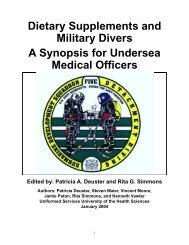Force Health Protection: Nutrition and Exercise Resource Manual
Force Health Protection: Nutrition and Exercise Resource Manual
Force Health Protection: Nutrition and Exercise Resource Manual
You also want an ePaper? Increase the reach of your titles
YUMPU automatically turns print PDFs into web optimized ePapers that Google loves.
Countering Age-Associated<br />
Changes in Fitness<br />
Ever heard the saying “use it or lose it?” This is true for physical fitness.<br />
Whether it is muscle strength or aerobic endurance, if you do not remain<br />
physically active as you age you cannot maintain the muscle mass or heart<br />
adaptations you need for peak performance (review the effects of detraining<br />
listed in Chapter 4). Though aging can lead to decreases in fitness levels, the<br />
amount of decline is strictly dependent on your exercise routine. Therefore,<br />
age itself does not predispose you to have large decrements in physical<br />
performance.<br />
Some gradual changes you can expect in your<br />
physical performance as you age are listed below.<br />
◆ Aerobic Capacity - Declines in aerobic<br />
capacity, about 5% to 15% per decade, can<br />
start occurring after the age of 30. This is<br />
due to a combination of less physical<br />
activity, a lowering of the maximal heart<br />
rate, <strong>and</strong> decreases in the elasticity of the<br />
blood vessels. Declines in aerobic capacity<br />
can be minimized by maintaining a<br />
regular aerobic exercise routine. In<br />
particular, maintaining your exercise intensity, even if you<br />
exercise less frequently each week, will enable you to preserve<br />
much of your cardiorespiratory fitness as you age (see Chapters 4,<br />
5, <strong>and</strong> 6).<br />
◆ Anaerobic Performance - Declines more than aerobic capacity<br />
mainly because people tend to perform less near-maximal<br />
exercise as they age. This decline can be minimized by<br />
performing speed work in addition to your aerobic conditioning<br />
(see Chapter 5 for performance-related workouts). Training for<br />
speed is only necessary if you want to maintain your<br />
performance-related fitness or are still participating in<br />
competitive sports (see Chapters 4 <strong>and</strong> 5).<br />
◆ Muscle Mass <strong>and</strong> Strength - Both muscle mass, particularly<br />
the fast twitch fibers, <strong>and</strong> muscle strength decline after the age<br />
of 40. Losses can be minimized <strong>and</strong> even reversed if strength<br />
training exercises are performed regularly. As with aerobic<br />
fitness, the intensity of the strength exercises will determine the<br />
degree of your training benefits <strong>and</strong> slow the loss of muscle as<br />
you age (see Chapters 4, 7, 8, 10, <strong>and</strong> Appendix C).<br />
<strong>Nutrition</strong> <strong>and</strong> <strong>Exercise</strong> <strong>Resource</strong> <strong>Manual</strong> 119




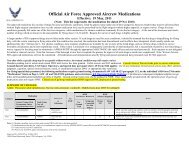
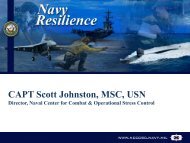
![Body Composition and Military [PDF] - Human Performance ...](https://img.yumpu.com/43269347/1/190x245/body-composition-and-military-pdf-human-performance-.jpg?quality=85)
![Tips for Grocery Shopping [PDF]](https://img.yumpu.com/37447379/1/190x245/tips-for-grocery-shopping-pdf.jpg?quality=85)
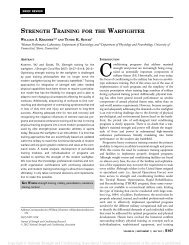
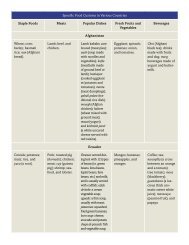
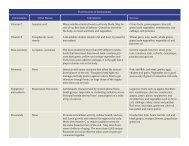
![Synthetic Drugs [PDF] - Human Performance Resource Center](https://img.yumpu.com/37447322/1/190x245/synthetic-drugs-pdf-human-performance-resource-center.jpg?quality=85)
